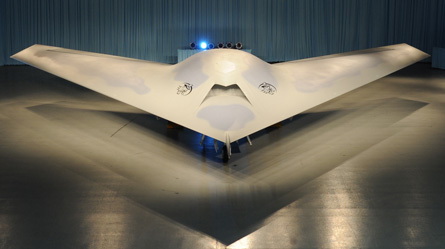Boeing rolled out a flight-ready Phantom Ray unmanned air system demonstrator on 10 May, but first flight remains scheduled for December.
The flying-wing design is heavily based on the X-45C programme cancelled by the US Air Force in 2006, but the roll-out event in St Louis, Missouri revealed an all-new ground control station.
Boeing plans to complete up to 10 flight tests with the Phantom Ray in 2011, says programme manager Craig Brown. The effort is typical of a new company strategy to develop new platforms ahead of a requirement defined by the US Department of Defense.
 |
|---|
© Boeing |
But the programme also benefits from nearly a decade of investment on the X-45C by the US Air Force and Defense Advanced Research Projects Agency, which envisaged the aircraft penetrating hostile airspace and preying on surface-to-air missile batteries.
The Phantom Ray, with a 16,500kg (36,500lb) gross weight, is not expected to carry sensors or weapons during the flight tests. But the demonstration aims to achieve more by checking out the flying qualities of the 15.2m (50ft)-wingspan UAS, which is powered by a non-afterburning General Electric F404-102D engine.
Boeing's new ground station intends to introduce advanced levels of autonomy. Similar to the Northrop Grumman RQ-4 Global Hawk, the Phantom Ray will be piloted on the ground using a mouse and a keyboard.
"It's like sitting at a computer at your desk," Brown says.
Boeing so far has not determined if the aircraft will require a separate sensor operator.
The demonstration next year involves controlling only one flying aircraft, but Boeing hopes the data can be extrapolated for research on concepts for controlling four flying aircraft with a single pilot, Brown says.
"If we take a look at the requirements to be able to safely and repeatedly control one air vehicle with one pilot, then we've got the confidence to move on to the second air vehicle," he says.
Boeing previously offered the X-45C to the US Navy for the unmanned combat air systems-demonstrator programme, but lost to Northrop's X-47B.
Boeing does not expect the Phantom Ray to compete for a new USN requirement called the unmanned carrier launched airborne surveillance and strike system, Brown says.
"For the resources it would take to navalise Phantom Ray," he says, Boeing will probably decide to "spend them somewhere else".
Source: Flight International



















